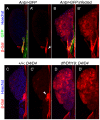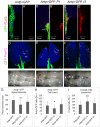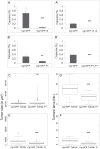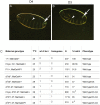Polydnaviral ankyrin proteins aid parasitic wasp survival by coordinate and selective inhibition of hematopoietic and immune NF-kappa B signaling in insect hosts
- PMID: 24009508
- PMCID: PMC3757122
- DOI: 10.1371/journal.ppat.1003580
Polydnaviral ankyrin proteins aid parasitic wasp survival by coordinate and selective inhibition of hematopoietic and immune NF-kappa B signaling in insect hosts
Abstract
Polydnaviruses are mutualists of their parasitoid wasps and express genes in immune cells of their Lepidopteran hosts. Polydnaviral genomes carry multiple copies of viral ankyrins or vankyrins. Vankyrin proteins are homologous to IκB proteins, but lack sequences for regulated degradation. We tested if Ichnoviral Vankyrins differentially impede Toll-NF-κB-dependent hematopoietic and immune signaling in a heterologous in vivo Drosophila, system. We first show that hematopoiesis and the cellular encapsulation response against parasitoid wasps are tightly-linked via NF-κB signaling. The niche, which neighbors the larval hematopoietic progenitors, responds to parasite infection. Drosophila NF-κB proteins are expressed in the niche, and non cell-autonomously influence fate choice in basal and parasite-activated hematopoiesis. These effects are blocked by the Vankyrin I²-vank-3, but not by P-vank-1, as is the expression of a NF-κB target transgene. I²-vank-3 and P-vank-1 differentially obstruct cellular and humoral inflammation. Additionally, their maternal expression weakens ventral embryonic patterning. We propose that selective perturbation of NF-κB-IκB interactions in natural hosts of parasitic wasps negatively impacts the outcome of hematopoietic and immune signaling and this immune deficit contributes to parasite survival and species success in nature.
Conflict of interest statement
The authors have declared that no competing interests exist.
Figures









Similar articles
-
Ikappabeta-related vankyrin genes in the Campoletis sonorensis ichnovirus: temporal and tissue-specific patterns of expression in parasitized Heliothis virescens lepidopteran hosts.J Virol. 2005 Jun;79(12):7617-28. doi: 10.1128/JVI.79.12.7617-7628.2005. J Virol. 2005. PMID: 15919914 Free PMC article.
-
Polydnavirus Ank proteins bind NF-κB homodimers and inhibit processing of Relish.PLoS Pathog. 2012;8(5):e1002722. doi: 10.1371/journal.ppat.1002722. Epub 2012 May 24. PLoS Pathog. 2012. PMID: 22654665 Free PMC article.
-
Cloning and characterization of two Campoletis chlorideae ichnovirus vankyrin genes expressed in parasitized host Helicoverpa armigera.J Insect Physiol. 2007 Jul;53(7):699-707. doi: 10.1016/j.jinsphys.2007.03.015. Epub 2007 Apr 10. J Insect Physiol. 2007. PMID: 17512002
-
Origin and evolution of polydnaviruses by symbiogenesis of insect DNA viruses in endoparasitic wasps.J Insect Physiol. 2003 May;49(5):419-32. doi: 10.1016/s0022-1910(03)00059-3. J Insect Physiol. 2003. PMID: 12770621 Review.
-
The Drosophila Toll signaling pathway.J Immunol. 2011 Jan 15;186(2):649-56. doi: 10.4049/jimmunol.1002302. J Immunol. 2011. PMID: 21209287 Review.
Cited by
-
In Silico Analysis of a Drosophila Parasitoid Venom Peptide Reveals Prevalence of the Cation-Polar-Cation Clip Motif in Knottin Proteins.Pathogens. 2023 Jan 14;12(1):143. doi: 10.3390/pathogens12010143. Pathogens. 2023. PMID: 36678491 Free PMC article.
-
Extensive transcription analysis of the Hyposoter didymator Ichnovirus genome in permissive and non-permissive lepidopteran host species.PLoS One. 2014 Aug 12;9(8):e104072. doi: 10.1371/journal.pone.0104072. eCollection 2014. PLoS One. 2014. PMID: 25117496 Free PMC article.
-
Improving the baculovirus expression vector system with vankyrin-enhanced technology.Biotechnol Prog. 2017 Nov;33(6):1496-1507. doi: 10.1002/btpr.2516. Epub 2017 Jul 6. Biotechnol Prog. 2017. PMID: 28649776 Free PMC article.
-
Regulation of the Larval Transcriptome of Diatraea saccharalis (Lepidoptera: Crambidae) by Maternal and Other Factors of the Parasitoid Cotesia flavipes (Hymenoptera: Braconidae).Front Physiol. 2019 Sep 6;10:1106. doi: 10.3389/fphys.2019.01106. eCollection 2019. Front Physiol. 2019. PMID: 31555143 Free PMC article.
-
An Overview of Embryogenesis: External Morphology and Transcriptome Profiling in the Hemipteran Insect Nilaparvata lugens.Front Physiol. 2020 Feb 18;11:106. doi: 10.3389/fphys.2020.00106. eCollection 2020. Front Physiol. 2020. PMID: 32132932 Free PMC article.
References
-
- Krzemien J, Crozatier M, Vincent A (2010) Ontogeny of the Drosophila larval hematopoietic organ, hemocyte homeostasis and the dedicated cellular immune response to parasitism. Int J Dev Biol 54: 1117–1125. - PubMed
-
- Lanot R, Zachary D, Holder F, Meister M (2001) Postembryonic hematopoiesis in Drosophila. Dev Biol 230: 243–257. - PubMed
Publication types
MeSH terms
Substances
Grants and funding
LinkOut - more resources
Full Text Sources
Other Literature Sources
Molecular Biology Databases

